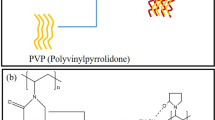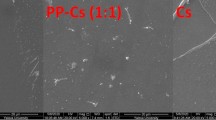Abstract
In this study, we investigated the miscibility and degradability of biodegradable polymers. Polydioxanone (PDO) was blended with chitosan, and the resulting films were prepared via film casting. The blends were analyzed according to composition ratio and in vitro biodegradation. The intermolecular interaction in the blend was verified through spectroscopic analysis. The addition of chitosan was found to lead to a significant enhancement in the mechanical properties of the blend. Also, the chitosan embedded film showed different morphologies and thermal properties from the pure PDO film. The current study might show a possibility of employing PDO based biodegradable film for biomedical applications.











Similar content being viewed by others
References
Di Raimondo R, Sanz-Esporrín J, Sanz-Martin I, Plá R, Luengo F, Vignoletti F, Nuñez J, Sanz M (2021) Hard and soft tissue changes after guided bone regeneration using two different barrier membranes: an experimental in vivo investigation. Clin Oral Investig 25(4):2213–2227
Guo H, Xia D, Zheng Y, Zhu Y, Liu Y, Zhou Y (2020) A pure zinc membrane with degradability and osteogenesis promotion for guided bone regeneration: in vitro and in vivo studies. Acta Biomater 106:396–409
Greenstein G, Greenstein B, Cavallaro J, Tarnow D (2009) The role of bone decortication in enhancing the results of guided bone regeneration: a literature review. J Periodontol 80(2):175–189
Gentile P, Chiono V, Tonda-Turo C, Ferreira AM, Ciardelli G (2011) Polymeric membranes for guided bone regeneration. Biotechnol J 6(10):1187–1197
Elgali I, Omar O, Dahlin C, Thomsen P (2017) Guided bone regeneration: materials and biological mechanisms revisited. Eur J Oral Sci 125(5):315–337
Jung RE, Fenner N, Hämmerle CH, Zitzmann NU (2013) Long-term outcome of implants placed with guided bone regeneration (GBR) using resorbable and non-resorbable membranes after 12–14 years. Clin Oral Implants Res 24(10):1065–1073
Peng W, Chen JX, Shan XF, Wang YC, He F, Wang XJ, Tan LL, Yang K (2019) Mg-based absorbable membrane for guided bone regeneration (GBR): a pilot study. Rare Met 38(6):577–587
Zhang L, Xiong C, Deng X (1995) Biodegradable polyester blends for biomedical application. J Appl Polym Sci 56(1):103–112
John J, Mani R, Bhattacharya M (2002) Evaluation of compatibility and properties of biodegradable polyester blends. J Polym Sci Part A: Polym Chem 40(12):2003–2014
Sabino MA, González S, Márquez L, Feijoo JL (2000) Study of the hydrolytic degradation of polydioxanone PPDX. Polym Degradation Stab 69(2):209–216
Bai W, Zhang LF, Li Q, Chen DL, Xiong CD (2010) In vitro hydrolytic degradation of poly (para-dioxanone)/poly (D, L-lactide) blends. Mater Chem Phys 122(1):79–86
Ebrahimpour M, Safekordi AA, Mousavi SM, Heydarinasab A (2018) A miscibility study on biodegradable poly butylene succinate/polydioxanone blends. J Polym Res 25(2):35
Ikejima T, Inoue Y (2000) Crystallization behavior and environmental biodegradability of the blend films of poly (3-hydroxybutyric acid) with chitin and chitosan. Carbohydr Polym 41(4):351–356
Kumar MNVR, Muzzarelli RAA, Muzzarelli C, Sashiwa H, Domb AJ (2004) Chitosan chemistry and pharmaceutical perspectives. Chem Rev 104(12):6017–6084
Chandy T, Sharma CP (1990) Chitosan-as a biomaterial. Biomater Artif Cells Artif Organs 18(1):1–24
Wan Y, Wu H, Yu A, Wen D (2006) Biodegradable polylactide/chitosan blend membranes. Biomacromol 7(4):1362–1372
Shih CM, Shieh YT, Twu YK (2009) Preparation and characterization of cellulose/chitosan blend films. Carbohydr Polym 78(1):169–174
Tamimi M, Rajabi S, Pezeshki-Modaress M (2020) Cardiac ECM/chitosan/alginate ternary scaffolds for cardiac tissue engineering application. Int J Biol Macromol 164:389–402
Ishikiriyama K, Pyda M, Zhang G, Forschner T, Grebowicz J, Wunderlich B (1998) Heat capacity of poly-p-dioxanone. J Macromol Sci B 37(1):27–44
Lustriane C, Dwivany FM, Suendo V, Reza M (2018) Effect of chitosan and chitosan-nanoparticles on post harvest quality of banana fruits. J Plant Biotechnol 45(1):36–44
Kapantaidakis G, Kaldis S, Dabou X, Sakellaropoulos G (1996) Gas permeation through PSF-PI miscible blend membranes. J Membr Sci 110(2):239–247
Piotrowska-Kirschling A, Brzeska J (2020) The effect of chitosan on the chemical structure, morphology, and selected properties of polyurethane/chitosan composites. Polymers 12(5):1205
Younes I, Hajji S, Frachet V, Rinaudo M, Jellouli K, Nasri M (2014) Chitin extraction from shrimp shell using enzymatic treatment. Antitumor, antioxidant and antimicrobial activities of chitosan. Int J Biol Macromol 69:489–498
Ikejima T, Yagi K, Inoue Y (1999) Thermal properties and crystallization behavior of poly (3-hydroxybutyric acid) in blends with chitin and chitosan. Macromol Chem Phys 200(2):413–421
Gartner C, López BL, Sierra L, Graf R, Spiess HW, Gaborieau M (2011) Interplay between structure and dynamics in chitosan films investigated with solid-state NMR, dynamic mechanical analysis, and X-ray diffraction. Biomacromol 12(4):1380–1386
Masson JF, Manley RSJ (1991) Cellulose/poly (4-vinylpyridine) blends. Macromolecules 24(22):5914–5921
Katicha SW, Flintsch GW (2012) Fractional viscoelastic models: master curve construction, interconversion, and numerical approximation. Rheol Acta 51(8):675–689
Abay AK, Gebeyehu MB, Lin HK, Lin PC, Lee JY, Wu CM, Murakami RI, Chiang TC (2016) Preparation and characterization of poly (lactic acid)/recycled polypropylene blends with and without the coupling agent, n-(6-aminohexyl) aminomethyltriethoxysilane. J Polym Res 23(9):198
Diab MA, El-Sonbati AZ, Bader DMD, Zoromba MS (2012) Thermal stability and degradation of chitosan modified by acetophenone. J Polym Environ 20(1):29–36
Han CM, Lih E, Choi SK, Bedair TM, Lee YJ, Park W, Han DK, Son JS, Joung YK (2018) Biodegradable sheath-core biphasic monofilament braided stent for bio-functional treatment of esophageal strictures. J Ind Eng Chem 67:396–406
Sharmin N, Khan RA, Salmieri S, Dussault D, Lacroix M (2012) Fabrication and characterization of biodegradable composite films made of using poly (caprolactone) reinforced with chitosan. J Polym Environ 20(3):698–705
Correlo V, Boesel L, Bhattacharya M, Mano J, Neves N, Reis R (2005) Properties of melt processed chitosan and aliphatic polyester blends. Mater Sci Eng 403(1–2):57–68
Böstman O (1991) Absorbable implants for the fixation of fractures. J Bone Joint Surg 73(1):148–153
Wu CS (2005) A comparison of the structure, thermal properties, and biodegradability of polycaprolactone/chitosan and acrylic acid grafted polycaprolactone/chitosan. Polymer 46(1):147–155
Torres-Huerta AM, Palma-Ramírez D, Dominguez-Crespo MA, Del Angel-López D, De La Fuente D (2014) Comparative assessment of miscibility and degradability on PET/PLA and PET/chitosan blends. Eur Polym J 61:285–299
Acknowledgements
This work was supported by the GRRC program of Gyeonggi Province (GRRC Dankook 2016–B03). In addition, this research was supported by the Basic Science Research Program through the National Research Foundation of Korea (NRF), funded by the Ministry of Education (2018R1A5A1024127).
Author information
Authors and Affiliations
Corresponding author
Ethics declarations
Conflict of interest
The authors declare no conflicts of financial or non-financial competing interest.
Additional information
Publisher's Note
Springer Nature remains neutral with regard to jurisdictional claims in published maps and institutional affiliations.
Rights and permissions
About this article
Cite this article
Nam, J.Y., Song, Y.S. Preparation and analysis of biodegradable polydioxanone/chitosan film. J Polym Res 29, 224 (2022). https://doi.org/10.1007/s10965-022-03082-7
Received:
Accepted:
Published:
DOI: https://doi.org/10.1007/s10965-022-03082-7




